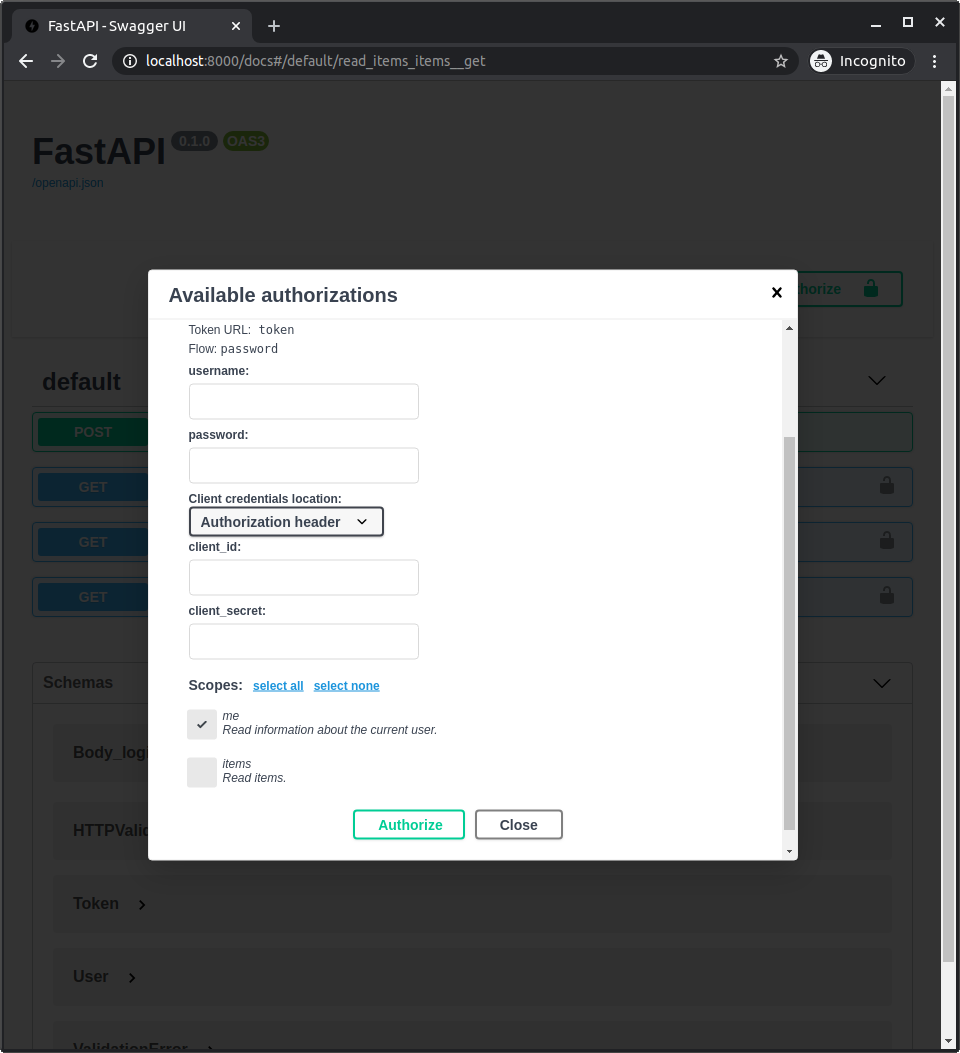作者:麦克煎蛋 出处:https://www.cnblogs.com/mazhiyong/ 转载请保留这段声明,谢谢!
OAuth2 scopes是一种细粒度的安全许可机制,通常用来对用户或者第三方应用提供特定的访问许可。
在OAuth2的规范中,scopes是一个基于空格分隔符的字符串列表。这些scopes代表着"许可"。
每一个scope项是一个不带空格的字符串,通常用来表示特定的安全许可,例如:
users:read或者users:write:这是通常的使用场景instagram_basic:Facebook / Instagram的使用场景https://www.googleapis.com/auth/drive: Google使用场景
scope的具体内容根据业务需求而定,对OAuth2来说只是字符串。
我们可以在FastAPI中直接使用无缝集成的OAuth2 scopes。
一、通过token返回scopes信息
1、后台获取权限
通常情况下,用户登陆成功以后,我们可以获取到用户真实的权限,并通过token返回scopes信息。
示例中的scopes信息仅是演示,使用时应该根据用户的实际系统权限来赋值。
@app.post("/login", response_model=Token) async def login_for_access_token(form_data: OAuth2PasswordRequestForm = Depends(), db: Session = Depends(get_db)): # 首先校验用户信息 user = authenticate_user(db, form_data.username, form_data.password) if not user: raise HTTPException( status_code=status.HTTP_401_UNAUTHORIZED, detail="Incorrect username or password", headers={"WWW-Authenticate": "Bearer"}, ) # 生成并返回token信息 access_token_expires = timedelta(minutes=ACCESS_TOKEN_EXPIRE_MINUTES) access_token = create_access_token( data={"sub": user.username, "scopes": "me"}, expires_delta=access_token_expires ) return {"access_token": access_token, "token_type": "bearer"}
2、用户登陆时选择
用户也可以在登陆时选择scopes信息,这也是Google等登陆时所用的机制。
我们需要在OAuth2PasswordBearer中添加scopes信息。
oauth2_scheme = OAuth2PasswordBearer( tokenUrl="token", scopes={"me": "Read information about the current user.", "items": "Read items."}, )
同样我们也是通过token返回scopes信息,只不过scopes信息的来源是用户端。
@app.post("/login2", response_model=Token) async def login_for_access_token2(form_data: OAuth2PasswordRequestForm = Depends(), db: Session = Depends(get_db)): # 首先校验用户信息 user = authenticate_user(db, form_data.username, form_data.password) if not user: raise HTTPException( status_code=status.HTTP_401_UNAUTHORIZED, detail="Incorrect username or password", headers={"WWW-Authenticate": "Bearer"}, ) # 生成并返回token信息 access_token_expires = timedelta(minutes=ACCESS_TOKEN_EXPIRE_MINUTES) access_token = create_access_token( data={"sub": user.username, "scopes": form_data.scopes}, expires_delta=access_token_expires ) return {"access_token": access_token, "token_type": "bearer"}
我们可以在交互式文档中查看显示效果:

二、scopes权限校验
当有请求访问时,需要从token中解析出有效信息,不仅需要完成用户身份校验,还需要完成基于scopes的权限校验。
1、scopes数据传递
首先需要在路径操作中添加对scopes的依赖项:
@app.get("/users/me/", response_model=User) async def read_users_me( current_user: User = Security(get_current_user, scopes=["me"]) ): return current_user
Security实际上是Depends的子类,只不过多了一个参数,可以接收scopes的列表信息。
通过使用Security而不是Depends,FastAPI将会知道它会声明并内部使用scopes信息,并且在交互式文档中显示这些信息。
2、scopes数据解析
SecurityScopes的属性scopes,是一个包含所有它需要的scopes以及所有依赖项(把它作为子依赖项)的列表。
SecurityScopes的属性scope_str,是包含所有scopes的一个字符串(以空格分隔)。
class SecurityScopes: def __init__(self, scopes: List[str] = None): self.scopes = scopes or [] self.scope_str = " ".join(self.scopes)
async def get_current_user(security_scopes: SecurityScopes, token: str = Depends(oauth2_scheme), db: Session = Depends(get_db)): if security_scopes.scopes: authenticate_value = f'Bearer scope="{security_scopes.scope_str}"' else: authenticate_value = f"Bearer" credentials_exception = HTTPException( status_code=status.HTTP_401_UNAUTHORIZED, detail="Could not validate credentials", headers={"WWW-Authenticate": authenticate_value}, ) try: payload = jwt.decode(token, SECRET_KEY, algorithms=[ALGORITHM]) username: str = payload.get("sub") print(username) if username is None: raise credentials_exception # 读取scopes信息 token_scopes = payload.get("scopes", []) token_data = TokenData(scopes=token_scopes, username=username) except (PyJWTError, ValidationError): raise credentials_exception # 用户身份校验 user = DBUser.get_by_username(db, token_data.username) if user is None: raise credentials_exception # 基于scope的权限校验 for scope in security_scopes.scopes: if scope not in token_data.scopes: raise HTTPException( status_code=status.HTTP_401_UNAUTHORIZED, detail="Not enough permissions", headers={"WWW-Authenticate": authenticate_value}, ) return user
3、依赖项树和scopes
修改部分代码逻辑如下:
async def get_current_active_user( current_user: User = Security(get_current_user, scopes=["me"]) ): if current_user.disabled: raise HTTPException(status_code=400, detail="Inactive user") return current_user @app.get("/users/me/", response_model=User) async def read_users_me( current_user: User = Security(get_current_active_user, scopes=["me"]) ): return current_user @app.get("/items/") async def read_items(token: str = Depends(oauth2_scheme)): return {"token": token} @app.get("/users/me/items/") async def read_own_items( current_user: User = Security(get_current_active_user, scopes=["items"]) ): return [{"item_id": "Foo", "owner": current_user.username}] @app.get("/status/") async def read_system_status(current_user: User = Depends(get_current_user)): return {"status": "ok"}
关于依赖项和scopes的层次提下如下:
路径操作read_own_items有:
* 依赖项需要的scopes: ["items"]
* 依赖项函数 get_current_active_user:
* 依赖项需要的scopes: ["me"]
* 依赖项函数 get_current_user:
* 自身不需要scopes
* 依赖项 oauth2_scheme
* SecurityScopes类型的参数security_scopes
* 参数security_scopes的属性scopes包含所有以上声明的scopes的一个列表,因此
* 对于路径操作 read_own_items来说,security_scopes.scopes 包含 ["me", "items"]
* 对于路径操作 read_users_me来说,security_scopes.scopes 包含 ["me"]
* 对于路径操作 read_system_status来说,security_scopes.scopes 的内容为[]